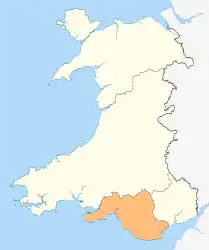Emergency planning in Wales
Emergency planning in Wales is carried out in line with the Civil Contingencies Act 2004 however as a result of devolution it is managed with its own ‘welsh flavour.’ For instance there are unique bodies operating in Wales like The Joint Emergency Services Group (JESG) and there is involvement from The Welsh Government.[1]
Wales Resilience Forum
The Wales Resilience Forum is the highest level of emergency planning in Wales. It meets three times a year and is chaired by the First Minister.[2]
Regional Local Resilience Forums
There are four Local Resilience Forums (LRF) in Wales, based on the areas of the four Welsh Police Areas:
- Dyfed Powys Local Resilience Forum (Dyfed Powys LRF or DPLRF)
- Gwent Local Resilience Forum (Gwent LRF or GLRF)
- North Wales Local Resilience Forum (North Wales LRF or NWLRF)
- South Wales Local Resilience Forum (South Wales LRF or SWLRF)
Each LRF includes the regional emergency services, the principal councils, and local health boards, a number of other government agencies that have responsibilities in the region, such as Public Health Wales and the Health and Safety Executive, and also transport agencies, utility companies, and the military.
The LRFs were established in 2004, as a requirement of the Civil Contingencies Act 2004, and effectively replaced the regional organisations such as the Gwent Emergency Planning and Liaison Group and the South Wales Emergency Services Liaison Committee that had been operating since 1994.[3][4]
Responsibilities
The Local Resilience Forums are responsible for assessing risks, planning responses, and recovery from a range of incidents that could have a major impact on their areas. Incidents are classified as hazards or threats.[5] Hazards are non-malicious events and typically include:[5]
- Transport accidents
- Severe weather
- Flooding
- Industrial accidents and environmental pollution
- Human health risks
- Animal health risks
- Industrial technical failure
Threats are planned events, such as a terrorist attack, and typically include:[5]
- Attacks using explosives
- Chemical, biological, radiological or nuclear threats
- Electronic attacks affecting utilities and communications
Legislation
The Local Regional Forums have specific duties defined by the following legislation:[6]
- Civil Contingencies Act 2004
- The Control of Major Accident Hazard Regulations 1999
- The Pipeline Safety Regulations 1996
- Radiation (Emergency Preparedness & Public Information) Regulations 2001
Summary and areas of the four Local Resilience Forums
| Forum | Emergency services | Principal councils | Health organisations | Area |
|---|---|---|---|---|
| Dyfed-Powys[7] |  | |||
| Gwent[8] |  | |||
| North Wales[9] |  | |||
| South Wales[10] |  |
In addition, a number of other government agencies are also partners of the four Welsh local resilience forums including:[8]
- British Transport Police
- Maritime and Coastguard Agency
- Public Health Wales
- Natural Resources Wales
- The Met Office
- Health and Safety Executive
- and also utility companies, transport agencies, and the military.
References
- "Wales Resilience website". The Welsh Government. Retrieved 2011-09-23.
- "Wales Resilience website". The Welsh Government. Retrieved 2011-09-23.
- "About Us". Gwent Prepared. Gwent Local Resilience Forum. 2016. Retrieved 5 October 2016.
- "Resilience". Mid and West Wales Fire and Rescue Service. 2012. Retrieved 5 October 2016.
- "Civil Contingencies". Dyfed-Poyws Police. 2015. Retrieved 5 October 2016.
- "Legislation". South Wales Resilience Forum. Retrieved 5 October 2016.
- "Further Information & Contacts". Dyfed Powys Community Risk Register (PDF) (Report). 1. Dyfed Powys Local Resilience Forum. November 2013. pp. 31–32. Retrieved 5 October 2016.
- "Our Partners". Gwent Prepared. Gwent Local Resilience Forum. Retrieved 5 October 2016.
- "Who are we?". North Wales Resilience Forum. Retrieved 5 October 2016.
- "Who are we?". South Wales Resilience Forum. Retrieved 5 October 2016.




